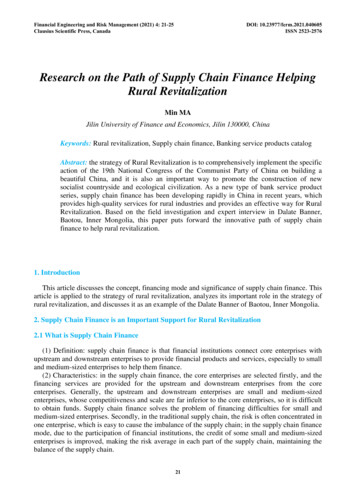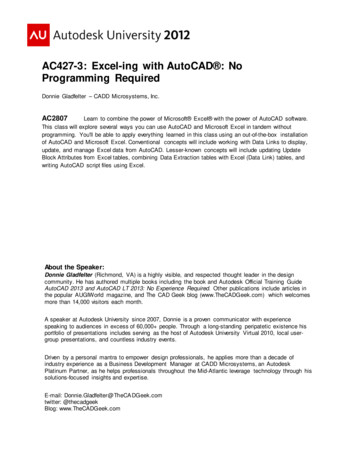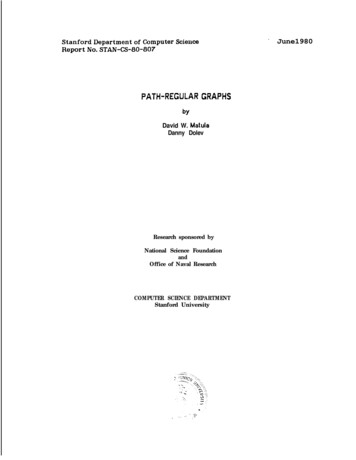
Transcription
DOI: 10.23977/ferm.2021.040605ISSN 2523-2576Financial Engineering and Risk Management (2021) 4: 21-25Clausius Scientific Press, CanadaResearch on the Path of Supply Chain Finance HelpingRural RevitalizationMin MAJilin University of Finance and Economics, Jilin 130000, ChinaKeywords: Rural revitalization, Supply chain finance, Banking service products catalogAbstract: the strategy of Rural Revitalization is to comprehensively implement the specificaction of the 19th National Congress of the Communist Party of China on building abeautiful China, and it is also an important way to promote the construction of newsocialist countryside and ecological civilization. As a new type of bank service productseries, supply chain finance has been developing rapidly in China in recent years, whichprovides high-quality services for rural industries and provides an effective way for RuralRevitalization. Based on the field investigation and expert interview in Dalate Banner,Baotou, Inner Mongolia, this paper puts forward the innovative path of supply chainfinance to help rural revitalization.1. IntroductionThis article discusses the concept, financing mode and significance of supply chain finance. Thisarticle is applied to the strategy of rural revitalization, analyzes its important role in the strategy ofrural revitalization, and discusses it as an example of the Dalate Banner of Baotou, Inner Mongolia.2. Supply Chain Finance is an Important Support for Rural Revitalization2.1 What is Supply Chain Finance(1) Definition: supply chain finance is that financial institutions connect core enterprises withupstream and downstream enterprises to provide financial products and services, especially to smalland medium-sized enterprises to help them finance.(2) Characteristics: in the supply chain finance, the core enterprises are selected firstly, and thefinancing services are provided for the upstream and downstream enterprises from the coreenterprises. Generally, the upstream and downstream enterprises are small and medium-sizedenterprises, whose competitiveness and scale are far inferior to the core enterprises, so it is difficultto obtain funds. Supply chain finance solves the problem of financing difficulties for small andmedium-sized enterprises. Secondly, in the traditional supply chain, the risk is often concentrated inone enterprise, which is easy to cause the imbalance of the supply chain; in the supply chain financemode, due to the participation of financial institutions, the credit of some small and medium-sizedenterprises is improved, making the risk average in each part of the supply chain, maintaining thebalance of the supply chain.21
2.2 Financing Mode of Supply Chain Finance(1) Receivables: accounts receivable financing. Accounts receivable financing is a kind offinancing mode in which the small and medium-sized enterprises in the upstream and downstreamof the supply chain can make loans to financial institutions with the unavailability of accountsreceivable under the premise that the core enterprises of the supply chain promise to pay.(2) Prepayment: financing of future cargo rights. Future cargo rights financing is a financingmode in which downstream buyers apply for loans from financial institutions to pay for the goodsdelivered by upstream core suppliers in a certain period of time. Meanwhile, suppliers promise tobuy back the undelivered goods and hand over the delivery rights to financial institutions.(3) Inventory: financing warehouse. The financing mode of financing warehouse is a kind offinancing mode in which the enterprise takes inventory as pledge, and after the evaluation andcertification of professional third-party logistics enterprises, financial institutions give credit tothem.2.3 The Significance of Supply Chain FinanceSupply chain finance, a new financing mode, can better help all enterprises in the supply chain tofinance, especially some small and medium-sized weak enterprises, so that some small andmedium-sized enterprises will no longer lose the opportunity to participate in the economic marketbecause of the shortage of funds and high risk, help them obtain more business opportunities andpromote the development of small and medium-sized enterprises. Secondly, supply chain financealso promotes the balance and development of the supply chain, averaging the risk to each part ofthe supply chain, and will not lead to the imbalance or even fracture of the whole supply chain dueto individual enterprises.3. The Current Situation and Dilemma of Rural Revitalization in China3.1 Status QuoTake my hometown Baotou City in Inner Mongolia as an example, Dalat banner is a banner andcounty district around Baotou. In 2018, the annual GDP of Dalat banner will grow by about 8%, thepublic budget revenue will increase by about 10%, the fixed asset investment of the whole societywill reach more than 20 billion, the total retail sales of consumer goods will increase by about 8%,the per capita disposable income of urban and rural residents will increase by about 7.5%, and theregistered urban unemployment rate will be controlled within 3.1%.Great achievements have beenmade in Rural Revitalization.3.2 DilemmaIn terms of scientific and technological innovation, the application scope of science andtechnology is limited, and some big data and cloud computing systems have not yet been built. Interms of finance, there are still some practical problems in the process of promoting the constructionof “agricultural financial service point”. The majority of farmers and herdsmen do not understandthe credit system, and there are problems in the establishment of credit villages and towns. Thereare some problems in the mortgage of housing, land use right and forest right in agricultural andpastoral areas.4. The Innovative Path of Supply Chain Finance for Rural Revitalization22
4.1 Building Financial Supply ChainRural areas are rich in natural resources, but many areas are still unable to get rid of poverty.Many rural enterprises are facing the problem of lack of funds and financing difficulties. Ruralfinancial institutions do not have a high understanding of supply chain finance, and thecorresponding services are less. Rural financial institutions should use the Internet, e-commerce andother platforms to build a supply chain financial system to connect “farmers, upstream anddownstream small and medium-sized enterprises, core enterprises and consumers”, so that somerural enterprises can develop and more agricultural and sideline products can go out of thecountryside. This not only allows more consumers to buy high-quality agricultural products, butalso drives the rapid development of rural economy. The supply chain financial system can rely onthe Internet platform to make loans more convenient for rural enterprises, obtain more businessopportunities and drive the development of enterprises.4.2 Design Financial Products Suitable for Rural EnterprisesRural financial institutions should adjust measures to local conditions and combine with thecurrent situation and characteristics of enterprises to design financial products suitable forenterprises. Different enterprises have different industries and development trends, so the financialproducts they need are also different. And the same enterprise in different stages, the financialproducts required are not exactly the same, which requires the rural financial institutions toconstantly carry out product innovation. Nowadays, with the rapid development of society,enterprises must keep up with the times and constantly update their business models and products.The financial products they need should also be innovated, so that financial products cancontinuously bring better benefits to enterprises and promote the development of enterprises.4.3 Take the Lead in Developing Key AreasThe focus of the work of rural financial institutions, first of all, should focus on some key areasand increase the service of key industries. For some areas that are still in poverty, rural financialinstitutions should provide supply chain financial services to local related enterprises, guideenterprises to adapt to this new financing mode, help enterprises establish links with downstreamenterprises, drive the development of enterprises, and enable enterprises to obtain benefits, so as todrive the economic development of local areas and make the poor areas get rid of poverty as soon aspossible. For key industries, rural financial institutions should strengthen their services, makesupply chain finance one of the effective financing modes of enterprises, help key industriesbecome bigger and stronger, and make key industries an indispensable part of the supply chain. Atthe same time, supply chain finance can also accelerate the rapid development of key areas such asthe integration of urban and rural areas, the integration of three rural industries, and basicagriculture.4.4 Introducing Financial TalentsThe revitalization of rural areas is inseparable from talents; the revitalization of rural economy isalso inseparable from financial talents. Rural areas are rich in products, but the conditions arerelatively backward, so it is difficult to attract talents. Rural financial institutions should activelyintroduce financial talents and integrate some high-quality financial talents with knowledge, abilityand quality into the Rural Revitalization Strategy. At the same time, financial talents should makefull use of the knowledge they have learned to promote the application and innovation of supply23
chain finance, popularize the supply chain finance to all rural enterprises, make enterprisesunderstand the supply chain finance, and apply it to the daily life of enterprises. In addition,financial personnel should also improve their own ideological level, not afraid to bear hardships andbe willing to contribute, so as to let their youth bloomPut it in the countryside, help the RuralRevitalization.4.5 Establish Corresponding Big Data and Risk Management SystemWith the development of economy, the volume of transactions is increasing, and it is easy toappear the phenomenon of asymmetric information, opaque transaction and unreliable data.Therefore, it is necessary to establish big data and risk management system. Using artificialintelligence, big data, cloud computing and other scientific and technological means, real-timemonitoring of transaction dynamics, analysis of data evaluation of enterprise situation, sharing ofinformation between different entities, effectively reducing the risk of supply chain. In the supplychain, rural enterprises are often small in scale, lack of credit and high risk. Some large enterprisesare unwilling to cooperate with them, which leads to the rupture of the supply chain and restricts thedevelopment of rural enterprises. The establishment of big data and risk management system,through the collection of data from all aspects of the supply chain, and the implementation ofsharing among the supply chain entities, to achieve information sharing, to avoid the phenomenonof information asymmetry; secondly, through the credit of the main supply chain and theenterprise's capital status evaluation, the risk of each link can be reduced. Within the controllablerange, different economic entities can make decisions in time to reduce damage.4.6 Preferential Policies of the GovernmentThe government should strengthen the guidance of rural enterprises, guide them to adapt to thenew financing mode of supply chain finance, and make them become a part of the supply chain. Weshould encourage rural financial institutions to actively promote the supply chain financial services.For rural financial institutions that provide supply chain financial services, we should givepreferential policies such as discount interest, reducing interest income tax and so on. We can givepriority to the development of a part of excellent rural enterprises, with their successful experiencein the use of supply chain finance, drive other rural enterprises to develop supply chain financerapidly, so as to promote the overall development of rural enterprises, the growth of rural economyand the revitalization of rural enterprises.5. ConclusionAs a new financing mode, supply chain finance has been initially developed in China in recentyears. In the future, the development of supply chain finance will be more and more rapid, and itwill be an inevitable trend to apply supply chain finance to rural revitalization. At present, China isin the final stage of poverty alleviation. If we can introduce the supply chain finance into thepoverty-stricken areas, help the enterprises in the poor areas to solve the problems of financingdifficulty and low credit, and make the enterprises in the poor areas enter the supply chain andbecome one of the main bodies of the supply chain, the enterprises can generate income, thusdriving the economic development of the poor areas and enriching the resources in the poor areas.We should make rational allocation and get rid of poverty.References24
[1] Feng Yancheng. Supply chain finance helps Rural Revitalization. China finance, No.10, pp.60-62, 2018.[2] Liu Gang. Research on the strategy of Internet supply chain finance helping rural revitalization. Theoreticaldiscussion, No.6, pp.118-123, 2019.[3] Chai Wenbo, Shen Xiangxin. Research on supply chain financial risk management based on big data environment.Business news, No.12, pp.85, 2020.[4] Hui Fengming. Research on the innovation of agricultural supply chain financial model in Guangdong Province.Hainan finance, No.4, pp.59-66, 2019.25
As a new financing mode, supply chain finance has been initially developed in China in recent years. In the future, the development of supply chain finance will be more and more rapidand it , will be an inevitable trend to apply supply chain finance to rural revitalization. At present, China is in the final stage of poverty alleviation.











